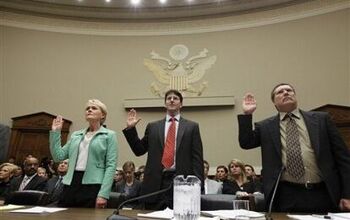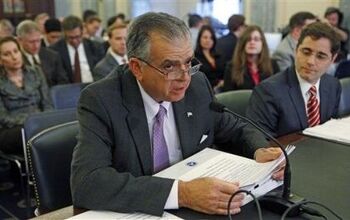Toyota Testimony, Day One: A Comedy In Three Parts: Act Two: The White Whale
Toyota’s Jim Lentz (who, I’m obligated to share, bears a striking resemblance to the dad from “Teen Wolf”) spent nearly two and a half hours before a committee that by then was investigating what expert witnesses described as an unknown, untraceable electronics error of nearly limitless reach. With this white whale taking the foreground of the committee’s imagination, the committee sharpened its harpoons, licked its lips and sailed out upon uncertain seas in search of its elusive quarry.
Lentz gave a straightforward statement describing Toyota’s response to the scandal, reiterating the company’s position that floormats or sticky gas pedals could explain Toyota’s UA problem. Lentz admitted that he was no engineer, but he refused to be pulled into quicksand of the vague claims of unidentified electronic problems. When told by the committee that Toyota’s counsel had admitted that sticky pedals might not explain “sudden high speed acceleration events,” Lentz eventually did admit that the floormat and pedal recalls won’t “totally” prevent future cases of unintended acceleration. “We need to remain vigilant,” said Lentz.
Lentz said that he was “confident” that Toyota’s testing of its electronic throttle control unit (ECTU) in Japan had turned up no problems. Chairman Waxman questioned how Dr Gilbert was able to come up with evidence of a problem (or at least evidence of a possible absence of evidence) within three hours of work on the ECTU, but Lentz claimed that Toyota’s (and its outside research firm Exponent’s) investigations hadn’t been able to reproduce them. In any case, Gilbert’s evidence didn’t show how malfunctions like the Smith’s actually happened.
Perhaps the biggest issue that Lentz faced was the fact that 70 percent of UA complaints in Toyota’s own database were in vehicles not affected by the recall. This was presented as evidence of the mysterious electronics scenario, a thrust that Lentz was obligated to defend against. But just as congress couldn’t tell Ms Smith that her story didn’t add up, Lentz made it very clear that he would not blame customers. Instead, he took the more politically palatable route of arguing definitions, arguing that sticky pedals would account for unintended acceleration but not sudden unintended acceleration. Though Lentz admitted that Toyota hadn’t responded well enough to consumer feedback, he brought unwanted nuance into the hearing by suggesting that all unintended acceleration is not created equal. As Lentz’s statement reads:
Why did it take so long to get to this point? With respect to pedal entrapment, Toyota conducted investigations of customer complaints which focused too narrowly on technical issues without taking full account of the way customers used our vehicles. And in the case of sticking accelerator pedals, we failed to promptly analyze and respond to information emerging from Europe and in the United States.
The upshot of Lentz’s epic grilling was that Toyota had grown too fast and that weaknesses in internal communication prevented the company from responding to in a timely manner to customer complaints. In this sense, he was surprisingly in step with the trial-lawyer-funded expert witnesses who will doubtless go on testify in several of the pending suits against Toyota. As Kane put it, unintended acceleration is a complex problem with a number of root causes. But while Kane’s agenda is to leverage this uncertainty into the perception of an as yet unidentified electronics problem, Lentz’s agenda was to suggest as tactfully as possible that human error (or, “the way our customers used our vehicles”) could play a role as well. The committee embraced complexity when it fit the outline of its white whale, but when Lentz broadened this complexity to include scenarios that take human fallibility into account, the hunting party was thrown into chaos.
Unable to catch sight of the white whale that the first panel of witnesses had sent them in search of, the committee had to satisfy itself with Lentz’s admission that it did not respond quickly enough to customer complaints. With the phantom menace still as mysteriously undefined as ever, the committee members who wanted more from Toyota than contrition over a failure to connect the dots in customer complaints resorted bashing Toyota for totally unrelated reasons. But by the time that California Rep. McNerney accused Toyota of not doing enough to prevent the shutdown of NUMMI, Lentz was pretty clearly out of the woods. Lentz’s rebuttal that GM’s pullout from NUMMI was the catalyst for what McNerney termed “Toyota’s antipathy to West Coast workers” reminded the committee that congress’s record in regulating the auto industry was hardly a sterling one.
Ultimately, Lentz left the hearing having admitted that Toyota was less than entirely competent in tracking its consumer feedback in order to keep its customers safe. In this sense, the hearing publicly shamed Toyota and cemented the damage that had already been done by the scandal. Where Lentz did succeed admirably was in putting the fevered distress over a possible software gremlin into context. In Lentz’s words:
Put simply, it has taken us too long to come to grips with a rare but serious set of safety issues, despite all of our good faith efforts.
Comedy is born in the space between our expectations and reality. Having been prepped by its expert witnesses to believe that Toyotas are afflicted with a mysterious, pervasive electronic gremlin, the House Energy Committee combed Lentz’s testimony for evidence of this improbable scenario. The ensuing attack on Toyota for the NUMMI closure would have been humorous enough, but the comedic irony in the situation goes even deeper: the shortcomings of human nature that led the committee on a convoluted search for simple answers to complex problems are the same shortcomings that lead individuals to concoct inexplicable narratives as the only possible explanation for their own failings in a moment of crisis. That Lentz was able to let this deceptively complex truth shine through in the midst of a congressional hearing (which are not known for their insightful nuance, to put it mildly) without explicitly blaming customers is a tribute to his performance. Though Toyota’s shortcomings in customer service were acknowledged, the committee failed to land their mythical quarry, which would have permanently destroyed Toyota’s reputation forever.
More by Edward Niedermeyer
Latest Car Reviews
Read moreLatest Product Reviews
Read moreRecent Comments
- ToolGuy The other day I attempted to check the engine oil in one of my old embarrassing vehicles and I guess the red shop towel I used wasn't genuine Snap-on (lots of counterfeits floating around) plus my driveway isn't completely level and long story short, the engine seized 3 minutes later.No more used cars for me, and nothing but dealer service from here on in (the journalists were right).
- Doughboy Wow, Merc knocks it out of the park with their naming convention… again. /s
- Doughboy I’ve seen car bras before, but never car beards. ZZ Top would be proud.
- Bkojote Allright, actual person who knows trucks here, the article gets it a bit wrong.First off, the Maverick is not at all comparable to a Tacoma just because they're both Hybrids. Or lemme be blunt, the butch-est non-hybrid Maverick Tremor is suitable for 2/10 difficulty trails, a Trailhunter is for about 5/10 or maybe 6/10, just about the upper end of any stock vehicle you're buying from the factory. Aside from a Sasquatch Bronco or Rubicon Jeep Wrangler you're looking at something you're towing back if you want more capability (or perhaps something you /wish/ you were towing back.)Now, where the real world difference should play out is on the trail, where a lot of low speed crawling usually saps efficiency, especially when loaded to the gills. Real world MPG from a 4Runner is about 12-13mpg, So if this loaded-with-overlander-catalog Trailhunter is still pulling in the 20's - or even 18-19, that's a massive improvement.
- Lou_BC "That’s expensive for a midsize pickup" All of the "offroad" midsize trucks fall in that 65k USD range. The ZR2 is probably the cheapest ( without Bison option).


































Comments
Join the conversation
Was anyone really expecting Congress to really be able to get to him? It isn't like he is going to say anything detrimental about the company. Saying Toyota can't reproduce what Gilbert is talking about is quite interesting. I am surprised that the leaked memos talking about Toyota saving money on recalls and delaying safety didn't come up in the meeting. Maybe they are saving that for Mr. Toyoda.
Sorry Ed, Mr. Lentz did say that driver error was one of the possible reasons for the engine speed to increase. He had a list of potential causes, "a/c idle up/down, etc., etc., driver error, etc." but Lentz only seemed to get thru the list completely (and to the 'driver error' point) once, and even then, Lentz said it more 'sotto-voce' as IIRC one of the congressmen was talking over him.